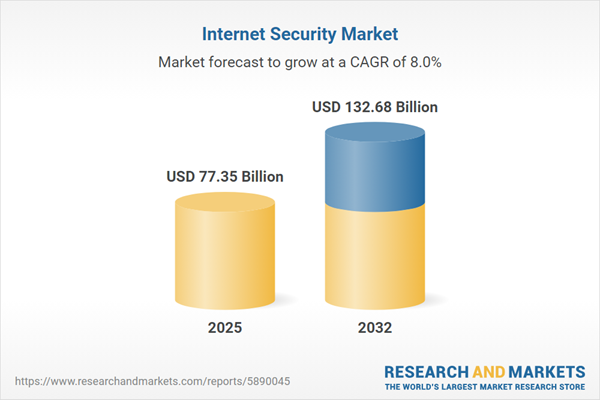Speak directly to the analyst to clarify any post sales queries you may have.
The Internet Security Market empowers organizations to safeguard digital assets and maintain compliance amid ongoing digital transformation. With adaptable security solutions, enterprises can confidently manage complex regulatory and operational demands while addressing the changing nature of cyber threats.
Market Snapshot: Internet Security Market Growth & Outlook
The Internet Security Market is currently valued at USD 71.60 billion and is forecast to reach USD 132.68 billion by 2032, reflecting an 8.01% CAGR. This expansion is fueled by broad enterprise migration to cloud-based environments, stricter global regulation, and the evolution of advanced cyber threats. Accordingly, organizations across industries are investing in robust, comprehensive security strategies designed to facilitate digital transformation while ensuring business continuity and operational resilience. Security frameworks are increasingly required to adapt in real time, integrating seamlessly with new infrastructure and addressing the heightened sophistication of today’s adversarial landscape.
Scope & Segmentation: Core Segments Shaping the Internet Security Market
- Security Types: Application security protects critical business software platforms. Cloud security fortifies both public and hybrid environments. Endpoint security focuses on safeguarding user devices. Network security uses intelligent detection and firewall technologies to defend complex, growing infrastructures.
- Deployment Modes: Cloud-based solutions enable organizations to achieve rapid scalability and flexible access through leading service providers. On-premises deployments provide custom policy control and governance, preferred by those with strict compliance or data residency obligations.
- Organization Sizes: Solutions address requirements across the full organizational spectrum—large enterprises, mid-sized businesses, SMEs, and micro organizations—helping each align risk management measures with their scale and compliance context.
- End Users: Financial services providers, government agencies, healthcare institutions, IT and telecom operators, and retailers choose market solutions that address specific data protection and compliance demands within their sectors.
- Threat Types: Defenses are built to address denial-of-service attacks, insider risks, ransomware, phishing (including spear phishing and smishing), spyware, adware, and malware. Businesses require multi-pronged detection and remediation strategies to counteract diverse threats.
- Attack Vectors: Organizations respond to phishing, compromised URLs, mobile-based intrusions, malicious code, brute-force approaches, and SMS-based exploits. Adaptive threat intelligence forms the backbone of modern cyber defense approaches.
- Regional Coverage: The Americas, EMEA, and Asia-Pacific show significant investment, with regulatory trends in the U.S., Germany, India, UAE, and Australia strongly influencing their security landscapes and risk mitigation priorities.
- Key Companies Profiled: Leading market players include Cisco Systems, Palo Alto Networks, Fortinet, Check Point Software Technologies, Broadcom, Trend Micro, CrowdStrike, Microsoft, IBM, and FireEye. These companies innovate in compliance-focused technology, adapting proactively to new cyber and regulatory environments.
Key Takeaways for Senior Decision-Makers
- Adopting zero trust security strategies ensures continual verification of users and devices, improving cyber resilience across distributed and hybrid workforce environments.
- Integration of artificial intelligence and machine learning enables real-time analysis of security events, resulting in faster and more effective threats response throughout the enterprise.
- Cloud-native and hybrid security models support flexibility, allowing organizations to efficiently scale resources and secure remote operations as digital transformation accelerates.
- Centralized security management platforms with modular features simplify oversight, providing efficient controls for organizations of varying size and complexity.
- Industries driven by regulatory requirements advance governance and risk management processes to keep pace with shifting global compliance obligations.
- Implementing multi-layered defense techniques strengthens protection across email, web, and mobile channels, reducing vulnerability and potential exposure of sensitive assets.
Tariff Impact: Navigating Shifts in 2025
New U.S. tariffs on cybersecurity technologies are prompting organizations to reevaluate procurement routes and supplier strategies. Many enterprises are expediting the transition toward flexible, cloud-oriented security architectures and diversifying their provider base to sustain competitive operations, address evolving risks, and maintain regulatory compliance.
Methodology & Data Sources
This analysis is built on interviews with industry experts, continuous monitoring of regulatory developments, and detailed technical assessments. All findings are validated independently to ensure an accurate reflection of the enterprise security risk landscape and provide actionable insights to stakeholders.
Internet Security Market: Why This Report Matters
- Enables executive teams to anticipate and adapt to emerging cyber threats, optimizing cybersecurity investment in alignment with operational and regulatory priorities.
- Equips organizations with effective benchmarking and planning tools, supporting dynamic adjustment of security posture in response to evolving risks.
- Facilitates the development of resilient operating models by linking security advancements with enhanced business continuity and cross-functional capabilities.
Conclusion
Aligning with regulatory developments and proactively investing in advanced security technologies supports organizational adaptability and continuity. This report offers strategies for reinforcing digital security and ensuring ongoing enterprise growth.
Additional Product Information:
- Purchase of this report includes 1 year online access with quarterly updates.
- This report can be updated on request. Please contact our Customer Experience team using the Ask a Question widget on our website.
Table of Contents
3. Executive Summary
4. Market Overview
7. Cumulative Impact of Artificial Intelligence 2025
Companies Mentioned
The companies profiled in this Internet Security market report include:- Cisco Systems, Inc.
- Palo Alto Networks, Inc.
- Fortinet, Inc.
- Check Point Software Technologies Ltd.
- Broadcom Inc.
- Trend Micro Incorporated
- CrowdStrike Holdings, Inc.
- Microsoft Corporation
- International Business Machines Corporation
- FireEye, Inc.
Table Information
| Report Attribute | Details |
|---|---|
| No. of Pages | 191 |
| Published | November 2025 |
| Forecast Period | 2025 - 2032 |
| Estimated Market Value ( USD | $ 77.35 Billion |
| Forecasted Market Value ( USD | $ 132.68 Billion |
| Compound Annual Growth Rate | 8.0% |
| Regions Covered | Global |
| No. of Companies Mentioned | 11 |









